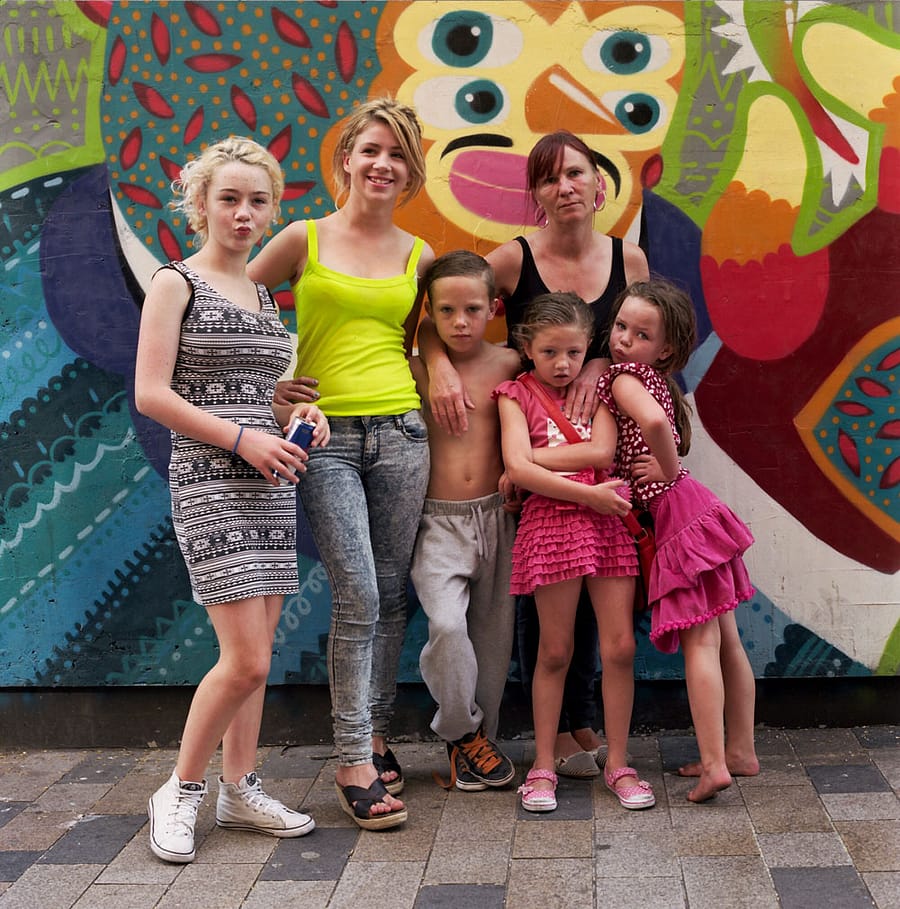 © Stuart Pilkington // Family in Blackpool from Strangers In Paradise
© Stuart Pilkington // Family in Blackpool from Strangers In Paradise
Photographer
Stuart Pilkington
The Story behind the Portrait
Text by Margaret Mitchell
I first ‘met’ Stuart a few years back when we exhibited together. I say ‘met’ because our meeting was conducted online, as many of Stuart’s photo friendships started due to his fantastic support of all things photography and photographer. Stuart experienced an untimely and serious stroke back in 2015 and the work he was doing was paused. With passing time, Stuart is increasingly showing his work again using his Facebook feed – a true delight to witness.
In 2017, I asked Stuart if I could show one of his images on The Story Portrait with the option of either Stuart, Linda (Stuart’s mum), or myself writing about it. Stuart decided he was happy for me to go ahead and discuss one of his images. Although I am not the photographer in this case, I hope what is offered here as a ‘story’ is of some value regarding the work.
I had a couple of images in mind from the outset but also visited his website to check that I still felt as strongly as I did about my initial choices. Stuart is a prolific photographer and the work he carried out for Strangers in Paradise saw new images appear with admirable frequency on his Facebook feed and website.
I love portrait photography and consider myself open to its many presentations. Nevertheless, environmental portraiture still draws me in more than any other – an image that relays information on the person but also offers something extra on the who, where and why. One of Stuart’s images from the group show tugged at me in particular. An image I didn’t really expect to feel ‘tugged’ by, so it made the image – and my reaction to it – all the more distinct. It made sense then to explore what it was that made me respond so deeply. I believe we all understand and react to photographs in very individual ways; sometimes with a photographer’s mind, where we admire another’s work, other times as a viewer with a reaction dependent on who we are, what our own background is, and the things that have shaped us in life.
The image of the family in Blackpool pulls me in. This incredibly intricate image, which on first glance seems to be an unassuming photograph of a family on a day out. But on looking at the faces, the bodies, the expressions, the interactions, the range of poses (or non-poses), the emotions from each member in the group, it suddenly becomes a very complex image. Group portraits can be incredibly difficult to do, with one person looking one way, another closing their eyes, or sneezing, or a multitude of other possibilities. A group environmental or street portrait can be even harder, less controlled, where the photographer might do a minimal amount of structuring and intervention (depending on the situation and the photographer of course).
I obviously don’t know the full story behind this portrait, I don’t know what Stuart said to them and I don’t know their interactions with him apart from what I interpret from this one image. Yet the image is not in my mind a reaction to Stuart but mostly a reflection of society, of a culture, to an invisible viewer. The dance between the bodies, the way they lean into one another, what each person is doing (or importantly, not doing) is what makes this portrait work, where its strength lies.
It encapsulates popular culture, childhood, parenthood, relationships and love, all in this one moment laid out on in front of us. The ‘duck face’ pose of one of the teens and the reflection of this somewhat expected ‘performance’ in one of the younger girls; the stance of the boy and the shyness of the other young girl with protective arms across herself. The eldest female at first seems to have a somewhat blank, even resigned look but on closer inspection all I can see is her arm lightly drooped over a young shoulder, an arm so at ease with itself that we just know she does this all the time. And another hand resting on another young shoulder. Holding on lightly, with love. And how they all fit beautifully into one another and into the background, which echoes their attitudes and warmth. But really I know nothing about this family or even if they are all part of the same family group. But I like them very much. They make me warm and they look like they love each another. Very much.
Photos can be problematic, where I, as the viewer make up an interpretation of a person’s life. Yet that is part of what photography is: the beauty of it, the power of it. Yet, ultimately it is also the weakness in photography that a viewer might interpret what is not there. As a photographer, this preoccupies me with every image I show in public: how it is interpreted and my responsibility as a photographer to those I photograph. It has been interesting and actually quite challenging to look at Stuart’s photograph and to explore why I am drawn to it. I am sure I could continue, delving into my own mind to see what factors cause me to like this particular image, but that’s for another place, another time.
This story has been a little about me, a little about Stuart, a little about photography, but mostly about a family I do not know. A family whose portrait is so perfect that I smile every time I look at it.
a story a little about me, a little about Stuart, a little about photography, but mostly about a family I do not know
Bio
Stuart Pilkington is an art photographer and curator based in the UK. You can read about Stuart’s Strangers In Paradise project over on his website. To read about his curatorial projects head over to Huck where you can also see the #selfieforStu video compiled by Tim Andrews in support of Stuart following his stroke.
As a curator, Stuart has initiated a number of global photography projects which have featured on the BBC, PDN and NPR amongst others. These include The Swap, The Alphabet Project, and 12 Faces.
